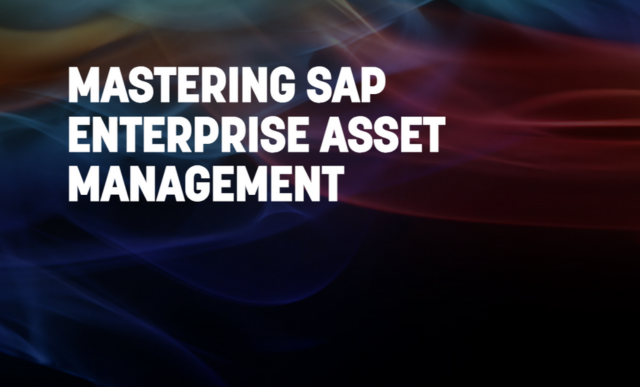SAP Enterprise Asset Management
SAP Asset Analytics | SAP Asset Tracking | SAP EAM | SAP Field Service | SAP GIS | SAP Maintenance Management | SAP Mobile Asset Management
What is Enterprise Asset Management?
Enterprise Asset Management (EAM) in SAP focuses on managing and maintaining an organization’s assets throughout its lifecycle. It employs systematic approaches such as asset tracking, planning, maintenance, and analysis to ensure optimal asset utilization and performance.
What is Enterprise Asset Management?
Enterprise Asset Management (EAM) in SAP focuses on managing and maintaining an organization’s assets throughout its lifecycle. It employs systematic approaches such as asset tracking, planning, maintenance, and analysis to ensure optimal asset utilization and performance.
By leveraging advanced technologies such as IoT (Internet of Things) sensors, predictive analytics, and cloud-based platforms, Enterprise Asset Management (EAM) in SAP enables organizations to monitor asset health, schedule preventive maintenance, manage repairs, and make informed decisions on asset acquisition or disposal. This proactive and data-driven approach to asset management helps organizations minimize downtime, reduce costs, extend asset lifespan, and improve overall operational productivity.
SAP Enterprise Asset Management (EAM) empowers organizations to align their asset management best practices with their broader organizational goals and achieve sustainable competitive advantage.
How Does an EAM System Work?
As the landscape of Enterprise Asset Management (EAM) in SAP continues to evolve, traditional on-premise systems have given way to modern cloud-based solutions. This technological advancement brings advantages like increased data storage capacities, enhanced security measures, and seamless integration with complementary applications such as supply chain management systems, mobile workforce management systems, Internet of Things (IoT) sensor systems, GIS (geographic information systems), GPS, and various other applications. By leveraging cloud platforms, organizations can efficiently manage their assets and also benefit from scalability, flexibility, and accessibility to real-time information while optimizing their asset management processes and driving operational excellence. EAM involves the following steps:
- Collecting and storing asset data in the cloud, utilizing the cloud’s agility to centralize asset information and generate analytical insights.
- Using data to guide asset strategy and optimize productivity by leveraging ML and predictive analytics to assess risks.
- Proactively schedule and maintain inspections, prioritize critical assets to minimize downtime, and resolving issues.
- Extending EAM system capabilities to workers enables management of work orders, asset processes, remote tracking, and maintenance process management.
Why is Asset Management Important?
Asset management is crucial for organizations across industries as it enables them to optimize the use of physical assets while minimizing downtime and maximizing returns. It also helps mitigate risks by proactively addressing potential failures and ensuring asset reliability. Informed decision-making is facilitated by analyzing asset data, allowing organizations to strategically plan investments, optimize portfolios and support regulatory compliance and ensure adherence to standards and regulations. Overall, effective asset management enhances operational efficiency, reduces risks, supports decision-making, and leads to improved profitability and long-term success.
SAP Intelligent Asset Management
SAP offers SAP Intelligent Asset Management, a suite of solutions that “enables an organization to use sensor technologies and predictive analytics to improve asset health.” The four solutions and some of their capabilities include:
- SAP Asset Intelligence Network SAP: Asset Intelligence Network offers collaborative capabilities and automated equipment tracking and enables organizations to seamlessly connect with stakeholders across the asset lifecycle. By leveraging this network, businesses can effectively manage and maintain their assets while benefiting from real-time insights. The platform automates equipment tracking and streamlines asset management processes, enhances operational efficiency, and enables proactive decision-making regarding maintenance, repairs, and replacement. SAP Asset Intelligence Network empowers organizations to optimize their EAM strategies, improve asset performance, and drive operational excellence in a collaborative and automated environment.
- SAP Predictive Asset Insights: SAP Predictive Asset Insights provides a 360-degree view of organizational assets and leverages advanced predictive analytics to generate a comprehensive view of assets, including their condition, performance, and maintenance requirements. The 360-degree view allows for real-time asset monitoring and tracking, enabling proactive maintenance and optimized asset utilization. With advanced predictive analytics algorithms, the solution enables forecasting asset failures and finding potential issues before they occur. By harnessing the power of data and analytics, SAP Predictive Asset Insights empowers organizations to make data-driven decisions, reduce downtime, improve operational efficiency, and enhance the overall performance and reliability of their asset portfolio.
- SAP Mobile Asset Management: SAP Mobile Asset Management streamlines work order management and enhances asset maintenance processes. The solution enables efficient work order creation, assignment, and tracking, empowering field workers and other users to access and update critical asset information in real time through mobile devices. SAP Mobile Asset Management allows organizations to optimize resource allocation, improve response times, and ensure the timely completion of maintenance tasks. The cloud-based deployment provides seamless integration, enabling organizations to harness the benefits of advanced analytics, IoT sensors, and other complementary applications to enhance asset management practices.
- SAP Asset Strategy and Performance Management: SAP Asset Strategy and Performance Management optimizes asset performance and enhances maintenance strategies by leveraging asset information management and failure modes and effects analysis (FMEA). Asset information management allows to capture, store, and manage critical asset information, including technical specifications, maintenance history, and documentation. This centralized repository enables easy access to asset data, facilitating informed decision-making and streamlined maintenance processes. The failure modes and effects analysis (FMEA) module enable organizations to identify potential failure modes of assets, assess their potential impact, and develop appropriate preventive and corrective maintenance strategies. SAP Asset Strategy and Performance Management empowers organizations to maximize the value of their assets, reduce downtime, and enhance operational efficiency through effective asset information management and failure modes analysis.
Join SAPinsider to access opportunities for networking and engagement in the dynamic SAP ecosystem. As a member, you will have access to a wealth of valuable resources and content tailored to SAP technologies and best practices like the latest research reports, articles, webinars, and events that will keep you informed and ahead of the curve.
SAPinsider membership grants you exclusive access to in-depth analyses, expert insights, and practical guidance that will empower you to navigate the ever-evolving SAP landscape with ease. SAPinsider membership will enable you to remain one step ahead and harness the latest trends, innovations, and strategies to drive your own powerful digital transformations, optimize your SAP investments, and unlock business success.
-

Rapid Agility with Scalable Capability
Reading time: 1 mins
Enterprise Technology and Business Systems Integrator Since 2002, M&S Consulting has been a trusted partner for both commercial and public sector clients, specializing in IT outsourcing and delivering innovative technology solutions for critical business functions. With M&S, you gain an experienced, multi-dimensional technology partner to lead, execute, and support any SAP implementation. Our team of…
-

-

- SAP Enterprise Asset Management
 Premium
Premium
The Emerging Role of AI in Enterprise Asset Management
Reading time: 8 mins
-

-

-

-

-

Featured Insiders
-

Laz Uriza
Business & Sales Strategy Director - WW SAP on Azure Strategy Lead
Global Sales & Strategy Lead, Microsoft
-

-

Jeff Smith
Loudoun Water
Become a Member
Unlimited access to thousands of resources for SAP-specific expertise that can only be found here.


